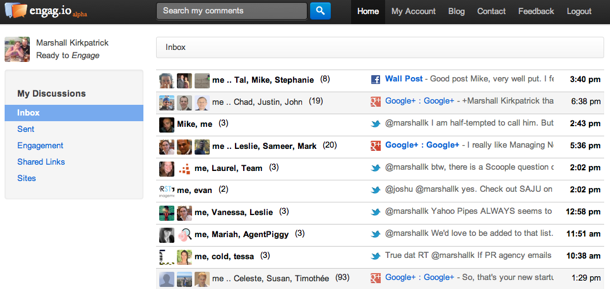Comments on blogs, what are they good for? Sometimes it’s hard to remember, but you know there’s a lot of potential in taking the democratization of publishing to the next level and letting people comment on your blog-written comments on the world.

This evening a fresh spate of debate has rolled over the tech blogosphere about whether it’s worth it to allow commenting on blog posts at all. Comment fields are spam magnets, their filled with trollish bile and abuse, they rarely offer meaningful discourse and they’re more trouble than they’re worth, critics say. Supporters contend otherwise, and as one of those, I offer below seven specific ways that new startups can optimize the discourse after a blog post has been published by its author. If these don’t work, maybe nothing will, but I think they are only the beginning. Give me a great Letter to the Editor of an old fashioned magazine, written by a real expert in the field who’s read and taken issue with a published article, and I’m in nerd heaven. Surely we can get some of that in the blogosphere. Comments are little tendrils of thought, structured and online. There’s no way that’s worthless.
Engagio
Blog comments aren’t just about call and response between blogger and audience, they’re about building a network of relationships. Engagio is a new startup, in limited beta right now, that really helps with that. It’s like CRM for your commenting across a wide variety of platforms. Your Engagio inbox tracks all the conversations you’ve begun on Twitter, Facebook, Google Plus, Disqus, HackerNews, Foursquare and elsewhere. All those threads are aggregated in one central place and it’s easy to circle back and stay engaged.
From a business perspective this can be useful in forming deeper relationships. But from an intellectual perspective it’s even better: the service facilitates deeper connections between people online, answers to your questions and easy recall of smart things people shared in response to your postings through its historical comment search. I log in to my Engagio inbox almost every day and it makes me wish I posted more comments around the web. The discourse I do engage in though is made much better by this simple tool for following through with conversation threads.
I reviewed Engagio in more depth here.

Disqus and the Top Vote Getters
Let readers vote up comments and then let them sort by the most up-voted comments. That’s something that many commenting platforms are beginning to offer. Did you know that Disqus (the platform we and many other blogs use) offers a page dedicated to the most active comment conversations across its network each day?
That page isn’t great, but it shows potential. If it were broken out by blog category (tech, politics, entertainment, etc.) it would be even better. I would link to a particularly good comment on Android fragmentation posted to Engadget that appears on that page, but honestly the page is so underdeveloped that the same Christmas Grinch that stole the still-anticipated Disqus API must have run away with its wits.
When you find a comment posted here at ReadWriteWeb, give a click to the commenter’s avatar. It’s really nice to see their history of commenting across the whole Disqus network of blogs. How long has it been since they posted here. Are they a regular RWW commenter? Where else to they read and discuss? This is metadata that gives context to a comment and it’s easy to see because of the way the data is surfaced.
Listening to What’s Upvoted – LiveFyre
Commenting system LiveFyre lets people not just post comments but also click to “listen” to a conversation. That means you’ll get an email sent to you whenever certain conditions are met, like when someone posts a comment on a post you’re listening to.
I don’t believe LiveFyre supports this yet, but it would be great if you could Listen to just comments that get at least one upvote. Or comments from people you’re connected with across social networks or comments from Friends of Friends. There’s a lot of potential in this Listening idea. Creative lurking, you might call it. There are powerful options that could be enabled for lurkers, the biggest population online.
Friend of a Friend as Spam Control
This is an idea people have talked about for years: why not use FOAF data as spam control? Show me comments that were posted by either friends on mine on social networks, or friends of my friends. At least by default.
Hypothes.is
Hypothes.is is a community funded and lead, really innovative, really exciting system being built to annotate online content down to the sentence level – and beyond. Commenting on offline items and objects. It looks fantastic – I’ve written about it here.
This startup, if it succeeds, is going to do a good job of serving up high quality comments from high quality commenters, all over the web. I’m really excited for it to launch.
Collapse Comments
Blogging platforms that let users downvote comments and then see those comments get collapsed into lesser visibility are good. Slashdot is of course the Granddaddy of this. Why would a person give up on commenting if they haven’t tried using a system like that?
Troll Mocking
Business Insider, a sprawling tech and business blog that’s more than a little trollish itself, has a great way of dealing with nasty comment posters. They are banished to the Water Cooler, a segment of comments adorned with cartoons of drunken vikings. It calls out trolls for what they are. I find it quite effective; I skip those comments if I’m in a hurry and I get my self-righteousness fix without nuking the whole conversation.
Update: It appears this feature has been removed from the site! The vikings are now well-behaved around a water cooler and offensive comments are removed as offensive! Oh well, I sure liked that idea.
There are so many options – and this is just the beginning. As social media is increasingly validated across society, commenting is only going to grow more comment. Hopefully the experience can be optimized. Self-satisfied blog-casters will suffer real losses in the long-term if they don’t experiment with tools that capture some of the incredible value made available by listening to voices outside their own. I’m just sayin’.
Photo: I Love Jesus because… by elsey_lovefusionphoto









